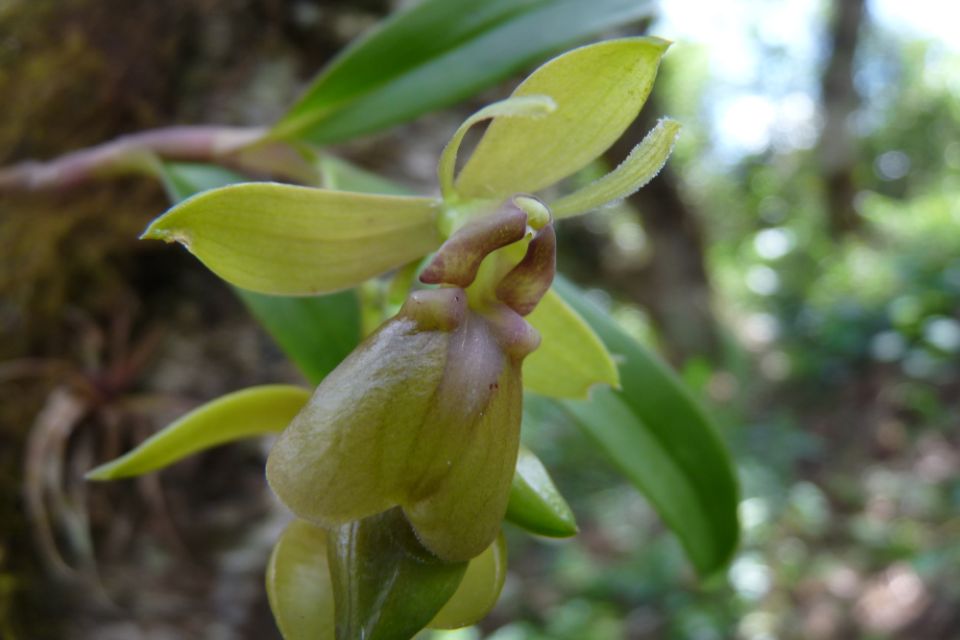

Epidendrum evelynae Rchb.f. 1878 GROUP Arbuscula SUBGROUP Incomptum
TYPE photo by G. Calatayud/TYPE Drawing by Jimenenz and The AMO Herbaria Website


 EARLY
EARLY
Common Name Evelyn's Epidendrum [?]
Flower Size 1.2" [3 cm]
Found in southern Peru and western Bolivia in montane forests at elevations of 1800 to 2650 meters as a medium sized, cool to cold growing epiphyte with simple, cane-like, terete, straight, new stem produced from the middle of the subapical internode of the previous stem and carrying 3 to 7, narrowly oblong, acute, sub-coriaceous, articulate, narrowly oblong, acute, smooth, margin entire leaves that blooms in the winter on a terminal, erect, arising on a mature stem, occuring only once, nodding, racemose, peduncle to .8" [2 cm] long, laterally compressed, ancipitous, rachis, unadorned, laterally compressed, [3 to 7 cm] long, overall, successively 4 to 7, 12 to 20 flowered inflorescence with much longer to shorter than the ovary, triangular, acuminate floral bracts and carrying resupinate, green flowers with the lip and apex of the column tinged with purple.
"Epidendrum evelynae belongs to the GROUP Arbuscula which is characterized by the erect habit with successive lateral growths produced from the middle of the previous growth, few leaves aggregate towards the apex of the stems, roots generally only from the base of the primordial stem, and the SUBGROUP Incomptum which has a short apical inflorescence with fleshy yellowish to green to violet-green to black flowers with short ovaries, the lip entire to 3-lobed. The species is recognized by the sub-coriaceous leaves, the successive flowers without any prominent ventral nectary which inflates the ovary, the reniform, bicallose lip, sepals .36 to .44" [9 to 11 mm] long, and the linear, single veined petals. Epidendrum chimantense Hágsater & Carnevali has the purple-tinged leaf-sheaths, narrow, elliptic-lanceolate leaves, the column arching only at the base and a slender, non-inflated ovary. Epidendrum lechleri Rchb. f., a species native to Peru, has .52" [13 mm] long sepals and a 3-lobed lip. Epidendrum nephroglossum Schltr. has very prominent floral bracts equal or longer than the ovary which is not swollen, acute petals and an obsolete clinandrium. Epidendrum bakrense has wider petals and shorter segments, with a much inflated ovary, and the column apex with a rounded lobe above the calli, not a tooth. Epidendrum rousseffianae Collantes & Hágsater has somewhat similar reniform lip, but the plant is quite different, with monopodial, branching stems. NOTES: Reichenbach described and in his sketch indicated the two calli followed by 3 short, parallel, narrow ribs. Our study of the isotype, and the photographs by Calatayud (from Cuzco), [this description note became E guislainae in 2018] clearly indicate two wide, divergent calli with a wide, thick mid-rib that runs the length of the lip, and thus is in contradiction with the protologue and thus was described as a new species in 2018 as guislainae. We presumed erroneously that the sketch by Reichenbach, and therefore his description was taken from a dried flower, where the fleshy, central mid-rib collapses, and in the process can be misinterpreted as three short ribs, which when rehydrated, recover the original form of one wide, thickened mid-rib. In addition the margin of the petals was not noted as minutely denticulate-erose. The photograph by Calatayud clearly shows 3-veined petals and was described in 2018 as E guislainae plate 1674 in 2018. Vásquez and Ibisch (2004) treated this species as a synonym of Epidendrum lechleri Rchb. f., together with Epidendrum nephroglossum Schltr. Dodson (1999) based his citation for Ecuador on a misidentified specimen, Dodson & Thien 2344 (MO!), which corresponds to Epidendrum homoion Hágsater & Dodson."
Synonyms
References W3 Tropicos, Kew Monocot list , IPNI ; Icones Orchidacearum 2 Plate 145 Hagsater & Sanchez 1993 see recognition section; Icones Orchidacearum 15 [1] Plate 1524 Hagsater 2015 drawing fide; Icones Orchidacearum 16[2] Plate 1674 Hagsater & Sanchez 2018 as E guislainae drawing/photo fide;
--------------------------------------------------------------------------------------------------------------------------
--------------------------------------------------------------------------------